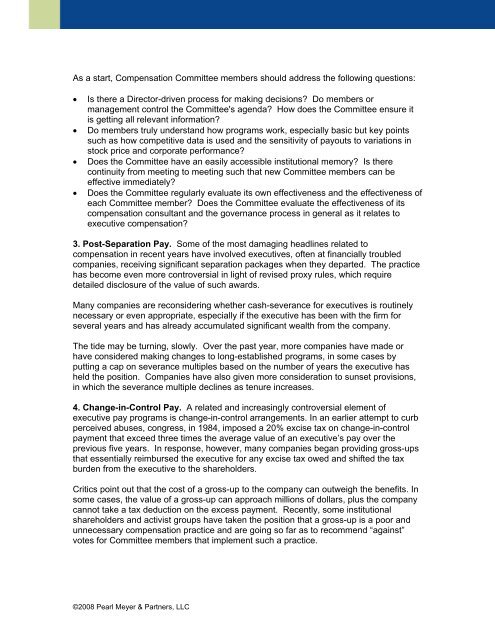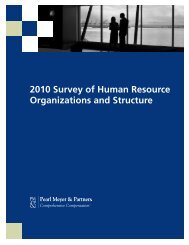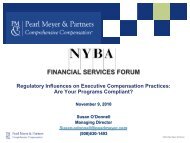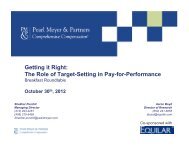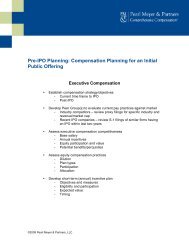Download - Pearl Meyer & Partners
Download - Pearl Meyer & Partners
Download - Pearl Meyer & Partners
You also want an ePaper? Increase the reach of your titles
YUMPU automatically turns print PDFs into web optimized ePapers that Google loves.
As a start, Compensation Committee members should address the following questions:<br />
• Is there a Director-driven process for making decisions? Do members or<br />
management control the Committee's agenda? How does the Committee ensure it<br />
is getting all relevant information?<br />
• Do members truly understand how programs work, especially basic but key points<br />
such as how competitive data is used and the sensitivity of payouts to variations in<br />
stock price and corporate performance?<br />
• Does the Committee have an easily accessible institutional memory? Is there<br />
continuity from meeting to meeting such that new Committee members can be<br />
effective immediately?<br />
• Does the Committee regularly evaluate its own effectiveness and the effectiveness of<br />
each Committee member? Does the Committee evaluate the effectiveness of its<br />
compensation consultant and the governance process in general as it relates to<br />
executive compensation?<br />
3. Post-Separation Pay. Some of the most damaging headlines related to<br />
compensation in recent years have involved executives, often at financially troubled<br />
companies, receiving significant separation packages when they departed. The practice<br />
has become even more controversial in light of revised proxy rules, which require<br />
detailed disclosure of the value of such awards.<br />
Many companies are reconsidering whether cash-severance for executives is routinely<br />
necessary or even appropriate, especially if the executive has been with the firm for<br />
several years and has already accumulated significant wealth from the company.<br />
The tide may be turning, slowly. Over the past year, more companies have made or<br />
have considered making changes to long-established programs, in some cases by<br />
putting a cap on severance multiples based on the number of years the executive has<br />
held the position. Companies have also given more consideration to sunset provisions,<br />
in which the severance multiple declines as tenure increases.<br />
4. Change-in-Control Pay. A related and increasingly controversial element of<br />
executive pay programs is change-in-control arrangements. In an earlier attempt to curb<br />
perceived abuses, congress, in 1984, imposed a 20% excise tax on change-in-control<br />
payment that exceed three times the average value of an executive’s pay over the<br />
previous five years. In response, however, many companies began providing gross-ups<br />
that essentially reimbursed the executive for any excise tax owed and shifted the tax<br />
burden from the executive to the shareholders.<br />
Critics point out that the cost of a gross-up to the company can outweigh the benefits. In<br />
some cases, the value of a gross-up can approach millions of dollars, plus the company<br />
cannot take a tax deduction on the excess payment. Recently, some institutional<br />
shareholders and activist groups have taken the position that a gross-up is a poor and<br />
unnecessary compensation practice and are going so far as to recommend “against”<br />
votes for Committee members that implement such a practice.<br />
©2008 <strong>Pearl</strong> <strong>Meyer</strong> & <strong>Partners</strong>, LLC


